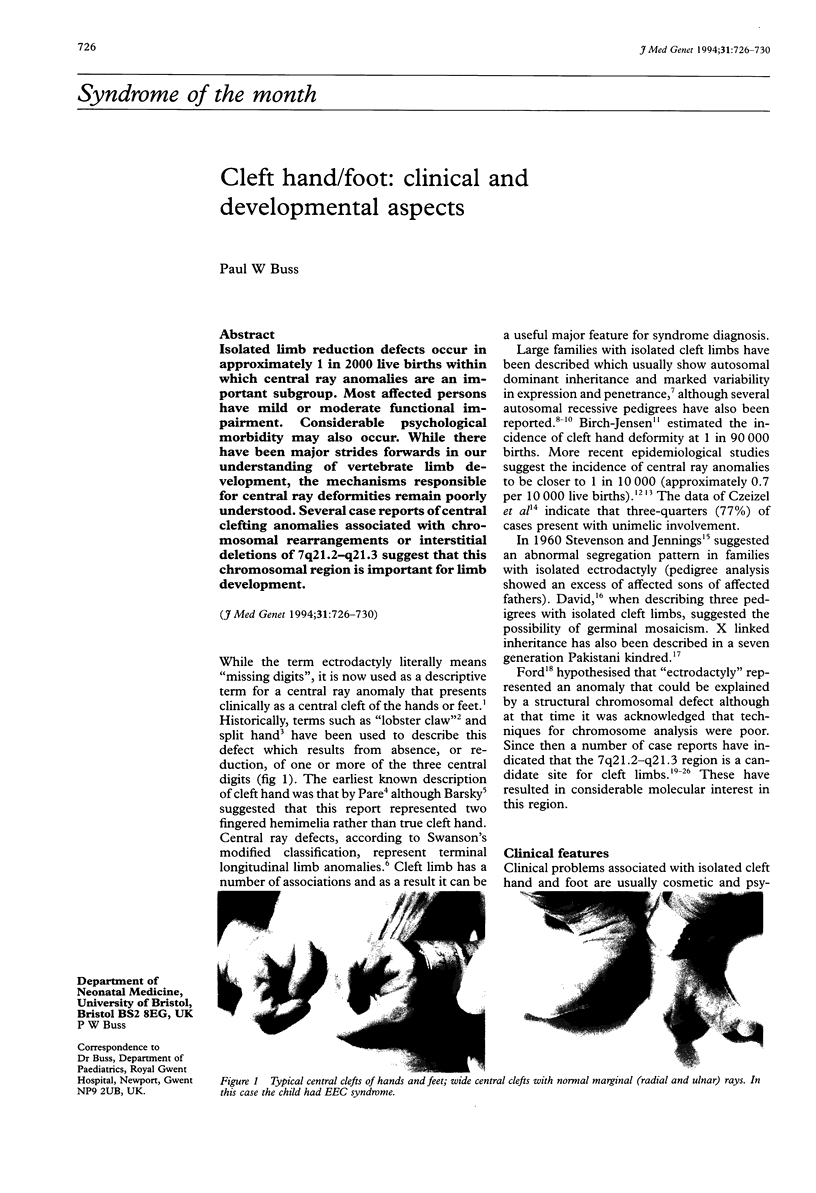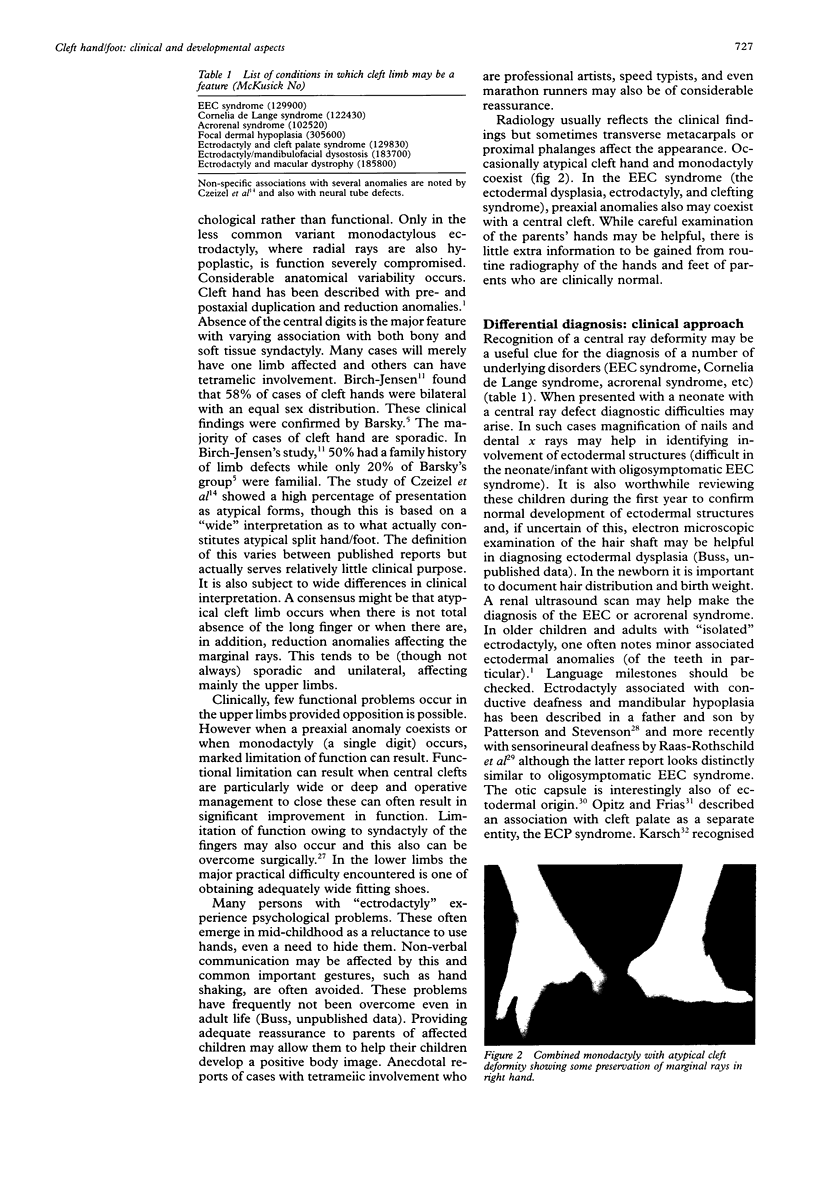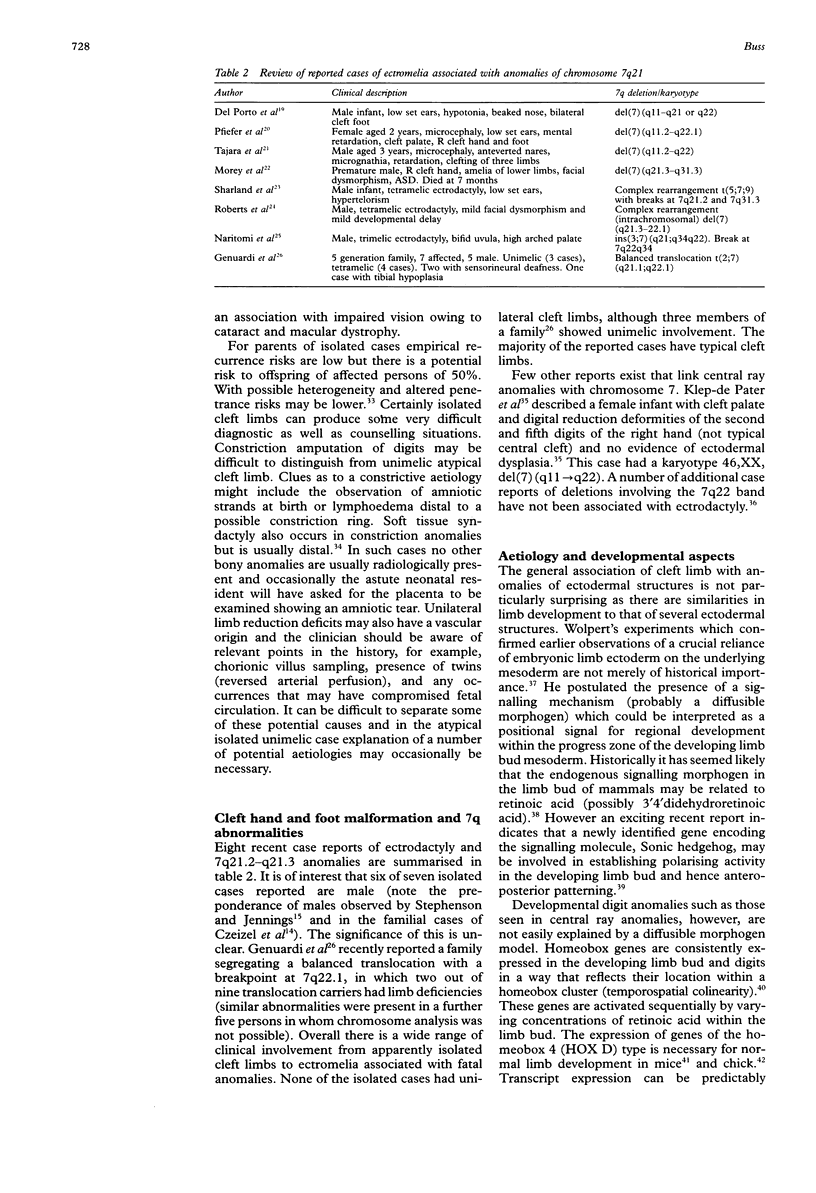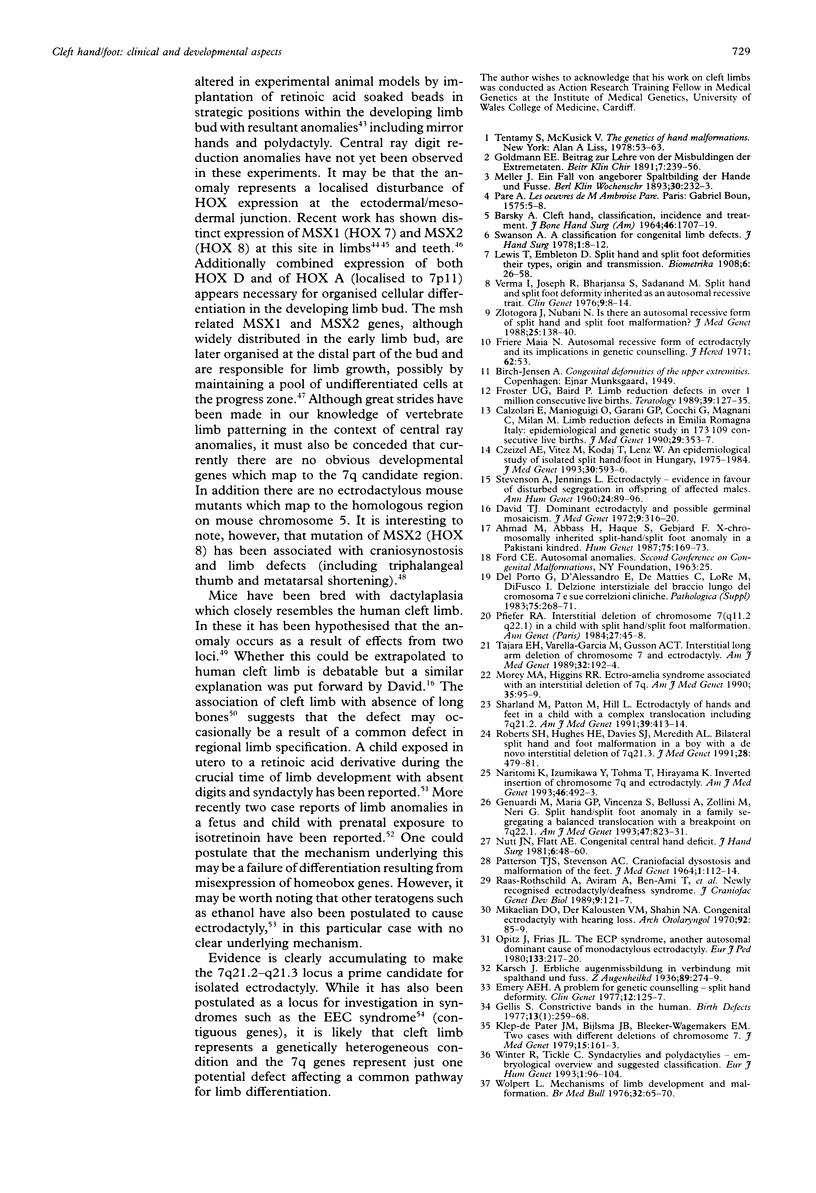Abstract
Isolated limb reduction defects occur in approximately 1 in 2000 live births within which central ray anomalies are an important subgroup. Most affected persons have mild or moderate functional impairment. Considerable psychological morbidity may also occur. While there have been major strides forwards in our understanding of vertebrate limb development, the mechanisms responsible for central ray deformities remain poorly understood. Several case reports of central clefting anomalies associated with chromosomal rearrangements or interstitial deletions of 7q21.2-q21.3 suggest that this chromosomal region is important for limb development.
Full text
PDF




Images in this article
Selected References
These references are in PubMed. This may not be the complete list of references from this article.
- Ahmad M., Abbas H., Haque S., Flatz G. X-chromosomally inherited split-hand/split-foot anomaly in a Pakistani kindred. Hum Genet. 1987 Feb;75(2):169–173. doi: 10.1007/BF00591081. [DOI] [PubMed] [Google Scholar]
- Bryant S. V., Gardiner D. M. Retinoic acid, local cell-cell interactions, and pattern formation in vertebrate limbs. Dev Biol. 1992 Jul;152(1):1–25. doi: 10.1016/0012-1606(92)90152-7. [DOI] [PubMed] [Google Scholar]
- Calzolari E., Manservigi D., Garani G. P., Cocchi G., Magnani C., Milan M. Limb reduction defects in Emilia Romagna, Italy: epidemiological and genetic study in 173,109 consecutive births. J Med Genet. 1990 Jun;27(6):353–357. doi: 10.1136/jmg.27.6.353. [DOI] [PMC free article] [PubMed] [Google Scholar]
- Chai C. K. Dactylaplasia in mice a two-locus model for development anomalies. J Hered. 1981 Jul-Aug;72(4):234–237. doi: 10.1093/oxfordjournals.jhered.a109486. [DOI] [PubMed] [Google Scholar]
- Czeizel A. E., Vitéz M., Kodaj I., Lenz W. An epidemiological study of isolated split hand/foot in Hungary, 1975-1984. J Med Genet. 1993 Jul;30(7):593–596. doi: 10.1136/jmg.30.7.593. [DOI] [PMC free article] [PubMed] [Google Scholar]
- David T. J. Dominant ectrodactyly and possible germinal mosaicism. J Med Genet. 1972 Sep;9(3):316–320. doi: 10.1136/jmg.9.3.316. [DOI] [PMC free article] [PubMed] [Google Scholar]
- Davidson D. R., Crawley A., Hill R. E., Tickle C. Position-dependent expression of two related homeobox genes in developing vertebrate limbs. Nature. 1991 Aug 1;352(6334):429–431. doi: 10.1038/352429a0. [DOI] [PubMed] [Google Scholar]
- Del Porto G., D'Alessandro E., De Matteis C., Lo Re M. L., Ivaldi M., Di Fusco C. Delezione interstiziale del braccio lungo del cromosoma 7 e sue correlazioni cliniche. Pathologica. 1983;75 (Suppl):268–271. [PubMed] [Google Scholar]
- Dollé P., Izpisúa-Belmonte J. C., Falkenstein H., Renucci A., Duboule D. Coordinate expression of the murine Hox-5 complex homoeobox-containing genes during limb pattern formation. Nature. 1989 Dec 14;342(6251):767–772. doi: 10.1038/342767a0. [DOI] [PubMed] [Google Scholar]
- Emery A. E. A problem for genetic counselling - split hand deformity. Clin Genet. 1977 Aug;12(2):125–127. doi: 10.1111/j.1399-0004.1977.tb00914.x. [DOI] [PubMed] [Google Scholar]
- Froster-Iskenius U. G., Baird P. A. Limb reduction defects in over one million consecutive livebirths. Teratology. 1989 Feb;39(2):127–135. doi: 10.1002/tera.1420390205. [DOI] [PubMed] [Google Scholar]
- Gellis S. S. Constrictive bands in the human. Birth Defects Orig Artic Ser. 1977;13(1):259–268. [PubMed] [Google Scholar]
- Genuardi M., Pomponi M. G., Sammito V., Bellussi A., Zollino M., Neri G. Split hand/split foot anomaly in a family segregating a balanced translocation with breakpoint on 7q22.1. Am J Med Genet. 1993 Nov 1;47(6):823–831. doi: 10.1002/ajmg.1320470606. [DOI] [PubMed] [Google Scholar]
- Herrmann J., Pallister P. D., Opitz J. M. Tetraectrodactyly and other skeletal manifestations in the fetal alcohol syndrome. Eur J Pediatr. 1980 May;133(3):221–226. doi: 10.1007/BF00496080. [DOI] [PubMed] [Google Scholar]
- Hoyme H. E., Jones K. L., Nyhan W. L., Pauli R. M., Robinow M. Autosomal dominant ectrodactyly and absence of long bones of upper or lower limbs: further clinical delineation. J Pediatr. 1987 Oct;111(4):538–543. doi: 10.1016/s0022-3476(87)80114-2. [DOI] [PubMed] [Google Scholar]
- Izpisúa-Belmonte J. C., Tickle C., Dollé P., Wolpert L., Duboule D. Expression of the homeobox Hox-4 genes and the specification of position in chick wing development. Nature. 1991 Apr 18;350(6319):585–589. doi: 10.1038/350585a0. [DOI] [PubMed] [Google Scholar]
- Jabs E. W., Müller U., Li X., Ma L., Luo W., Haworth I. S., Klisak I., Sparkes R., Warman M. L., Mulliken J. B. A mutation in the homeodomain of the human MSX2 gene in a family affected with autosomal dominant craniosynostosis. Cell. 1993 Nov 5;75(3):443–450. doi: 10.1016/0092-8674(93)90379-5. [DOI] [PubMed] [Google Scholar]
- Lewis E. B. A gene complex controlling segmentation in Drosophila. Nature. 1978 Dec 7;276(5688):565–570. doi: 10.1038/276565a0. [DOI] [PubMed] [Google Scholar]
- McBride W. G. Limb reduction deformities in child exposed to isotretinoin in utero on gestation days 26-40 only. Lancet. 1985 Jun 1;1(8440):1276–1276. doi: 10.1016/s0140-6736(85)92345-1. [DOI] [PubMed] [Google Scholar]
- Mikaelian D. O., Der Kaloustian V. M., Shahin N. A., Barsoumian V. M. Congenital ectodermal dysplasia with hearing loss. Arch Otolaryngol. 1970 Jul;92(1):85–89. doi: 10.1001/archotol.1970.04310010111016. [DOI] [PubMed] [Google Scholar]
- Morey M. A., Higgins R. R. Ectro-amelia syndrome associated with an interstitial deletion of 7q. Am J Med Genet. 1990 Jan;35(1):95–99. doi: 10.1002/ajmg.1320350118. [DOI] [PubMed] [Google Scholar]
- Naritomi K., Izumikawa Y., Tohma T., Hirayama K. Inverted insertion of chromosome 7q and ectrodactyly. Am J Med Genet. 1993 Jun 15;46(5):492–493. doi: 10.1002/ajmg.1320460505. [DOI] [PubMed] [Google Scholar]
- Nutt J. N., 3rd, Flatt A. E. Congenital central hand deficit. J Hand Surg Am. 1981 Jan;6(1):48–60. doi: 10.1016/s0363-5023(81)80011-1. [DOI] [PubMed] [Google Scholar]
- PATTERSON T. J., STEVENSON A. C. CRANIO-FACIAL DYSOSTOSIS AND MALFORMATIONS OF FEET. J Med Genet. 1964 Dec;1(2):112–114. doi: 10.1136/jmg.1.2.112. [DOI] [PMC free article] [PubMed] [Google Scholar]
- Qumsiyeh M. B. EEC syndrome (ectrodactyly, ectodermal dysplasia and cleft lip/palate) is on 7p11.2-q21.3. Clin Genet. 1992 Aug;42(2):101–101. doi: 10.1111/j.1399-0004.1992.tb03149.x. [DOI] [PubMed] [Google Scholar]
- Raas-Rothschild A., Aviram A., Ben-Ami T., Berger I., Katznelson M. B., Goodman R. M. Newly recognized ectrodactyly/deafness syndrome. J Craniofac Genet Dev Biol. 1989;9(2):121–127. [PubMed] [Google Scholar]
- Ragsdale C. W., Jr, Brockes J. P. Retinoids and their targets in vertebrate development. Curr Opin Cell Biol. 1991 Dec;3(6):928–934. doi: 10.1016/0955-0674(91)90109-c. [DOI] [PubMed] [Google Scholar]
- Riddle R. D., Johnson R. L., Laufer E., Tabin C. Sonic hedgehog mediates the polarizing activity of the ZPA. Cell. 1993 Dec 31;75(7):1401–1416. doi: 10.1016/0092-8674(93)90626-2. [DOI] [PubMed] [Google Scholar]
- Rizzo R., Lammer E. J., Parano E., Pavone L., Argyle J. C. Limb reduction defects in humans associated with prenatal isotretinoin exposure. Teratology. 1991 Dec;44(6):599–604. doi: 10.1002/tera.1420440602. [DOI] [PubMed] [Google Scholar]
- Robert B., Lyons G., Simandl B. K., Kuroiwa A., Buckingham M. The apical ectodermal ridge regulates Hox-7 and Hox-8 gene expression in developing chick limb buds. Genes Dev. 1991 Dec;5(12B):2363–2374. doi: 10.1101/gad.5.12b.2363. [DOI] [PubMed] [Google Scholar]
- Roberts S. H., Hughes H. E., Davies S. J., Meredith A. L. Bilateral split hand and split foot malformation in a boy with a de novo interstitial deletion of 7q21.3. J Med Genet. 1991 Jul;28(7):479–481. doi: 10.1136/jmg.28.7.479. [DOI] [PMC free article] [PubMed] [Google Scholar]
- STEVENSON A. C., JENNINGS L. M. Ectrodactyly--evidence in favour of a disturbed segregation in the offspring of affected males. Ann Hum Genet. 1960 Apr;24:89–96. doi: 10.1111/j.1469-1809.1959.tb01719.x. [DOI] [PubMed] [Google Scholar]
- Sharland M., Patton M. A., Hill L. Ectrodactyly of hands and feet in a child with a complex translocation including 7q21.2. Am J Med Genet. 1991 Jun 15;39(4):413–414. doi: 10.1002/ajmg.1320390410. [DOI] [PubMed] [Google Scholar]
- Tajara E. H., Varella-Garcia M., Gusson A. C. Interstitial long-arm deletion of chromosome 7 and ectrodactyly. Am J Med Genet. 1989 Feb;32(2):192–194. doi: 10.1002/ajmg.1320320212. [DOI] [PubMed] [Google Scholar]
- Tickle C. Vertebrate development. A tool for transgenesis. Nature. 1992 Jul 16;358(6383):188–189. doi: 10.1038/358188a0. [DOI] [PubMed] [Google Scholar]
- Verma I. C., Joseph R., Bhargava S., Mehta S. Split-hand and split-foot deformity inherited as an autosomal recessive trait. Clin Genet. 1976 Jan;9(1):8–14. doi: 10.1111/j.1399-0004.1976.tb01543.x. [DOI] [PubMed] [Google Scholar]
- Winter R. M., Tickle C. Syndactylies and polydactylies: embryological overview and suggested classification. Eur J Hum Genet. 1993;1(1):96–104. doi: 10.1159/000472392. [DOI] [PubMed] [Google Scholar]
- Wolpert L. Mechanisms of limb development and malformation. Br Med Bull. 1976 Jan;32(1):65–70. doi: 10.1093/oxfordjournals.bmb.a071326. [DOI] [PubMed] [Google Scholar]




